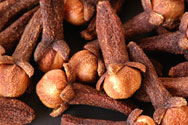 |
Clove
Syzygium aromaticum
Family: Myrtaceae
CTFA: Eugenia Caryophyllus (Clove) Flower Powder |
Return to herb list |

Photo © Steven Foster
Introduction
Native to the Moluccas Islands1 and Indonesia, clove has been introduced into East Africa, Malaysia, Madagascar, Brazil, and other tropical parts of the world.2 The small evergreen tree3 can grow to 30 feet and has oval leaves and yellow flowers.1 The tree’s flower buds are brown, less than a ½ inch in length2 and have a refreshing fragrance.3 Crushed or bruised leaves give off a strong fragrance which is characteristic of the clove.3 Clove is widely cultivated in warm regions and its flower buds are sun-dried for commercial spice.1 Oil from unexpanded flower buds can be expressed as easily as by pressing with a fingernail.2,3 History and Cultural Significance
A native custom of the Molucca Islands was to plant a tree whenever a child was born, thus producing many clove trees.4 Consequently, the Molucca Islands became known as the Spice Islands. It wasn’t until the fourth century that the spice arrived in Europe as a luxury item. From about the 1500s until the 1600s, the Portuguese built warehouses to gather and store cloves, which were shipped back to Europe, creating a monopoly on clove. In the early 17th century, the Dutch gained control of the trade and made clove more readily available to almost everyone for the first time.4 Clove oil has traditionally been used for culinary2 and medicinal purposes.3 In Asian medicine, dried flower buds of clove were used to treat toothaches.5 A major chemical component of clove, eugenol, is used in dental analgesic products.6 Today, clove and clove extracts are used as a flavoring for foods, beverages, and cigarettes8 and in cosmetics and perfumery.2 Clove cigarettes (kreteks) contain ground clove, mainly because eugenol is said to numb the throat.8 Clove extracts may be used in cosmetics and perfumery for their antioxidant effects as well as their pleasant fragrance.2 Modern Research
Currently, there are no clinical studies available on the internal or external uses of clove. Future Outlook
Flower heads are handpicked from the tree before they blossom in order to get whole cloves, possibly explaining their high value.7 In addition, clove trees require volcanic, loamy soil and much rainfall with moderate temperatures throughout the year limiting where it can be commercially grown.9 To assure a quality product, it is important to know how to choose good quality cloves. Quality cloves are fat, oily, and dark brown, while low quality cloves are dry and pale.3 References
1 Bailey LH, Bailey EZ. Hortus Third: A Consice Dictionary of Plants Cultivated in the United States and Canada. New York:Macmillan Publishing Company;1976. 2 Williamson EM. Potter’s Herbal Cyclopaedia. Saffron Walden: C.W. Daniel Company Limited;2003. 3 Grieve M. A Modern Herbal. Vol I. New York: Dover Publications, Inc.; 1971. 4 Gladen C. Cloves. 2005. Available at: http://www.bell.lib.umn.edu/Products/cloves.html. Accesed February 3, 2005. 5 Miyazawa M, Hisama M. Antimutagenic Activity of Phenylpropanoids from Clove (Syzygium aromaticum). Journal of Agricultural and Food Chemistry. 2003. 51:6413-6422. 6 Eugenol. Chemistry.org, The Website of the American Chemical Society. Available at: http://www.chemistry.org/portal/a/c/s/1/acsdisplay.html?DOC=HomeMolecule%5Carchive%5Cmotw_eugenol_arch.html. Accessed April 22, 2005. 7 Hill M, Barclay G, Hardy J. Southern Herb Growing. Fredericksburg, TX:Shearer Publishing;1997.
|